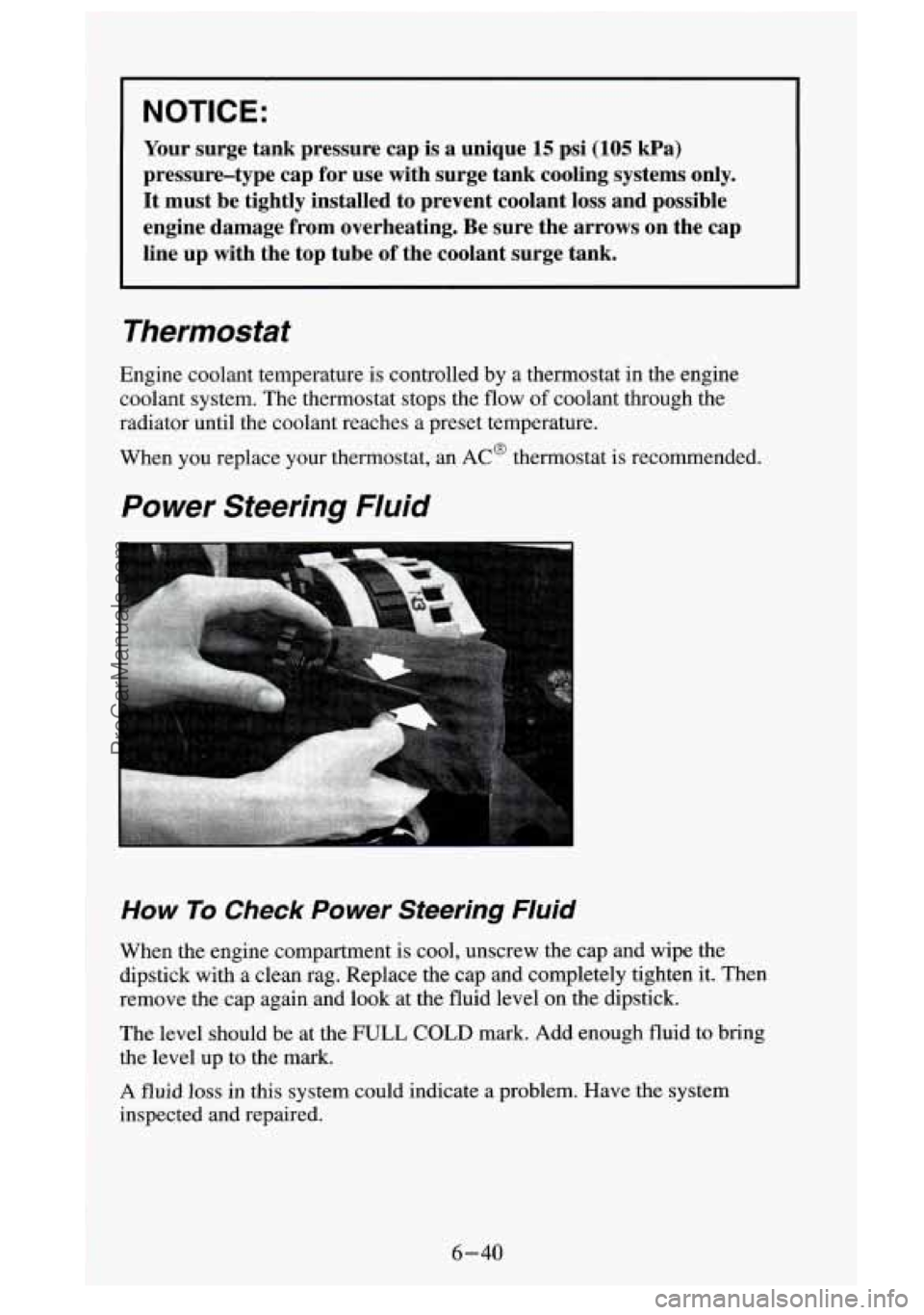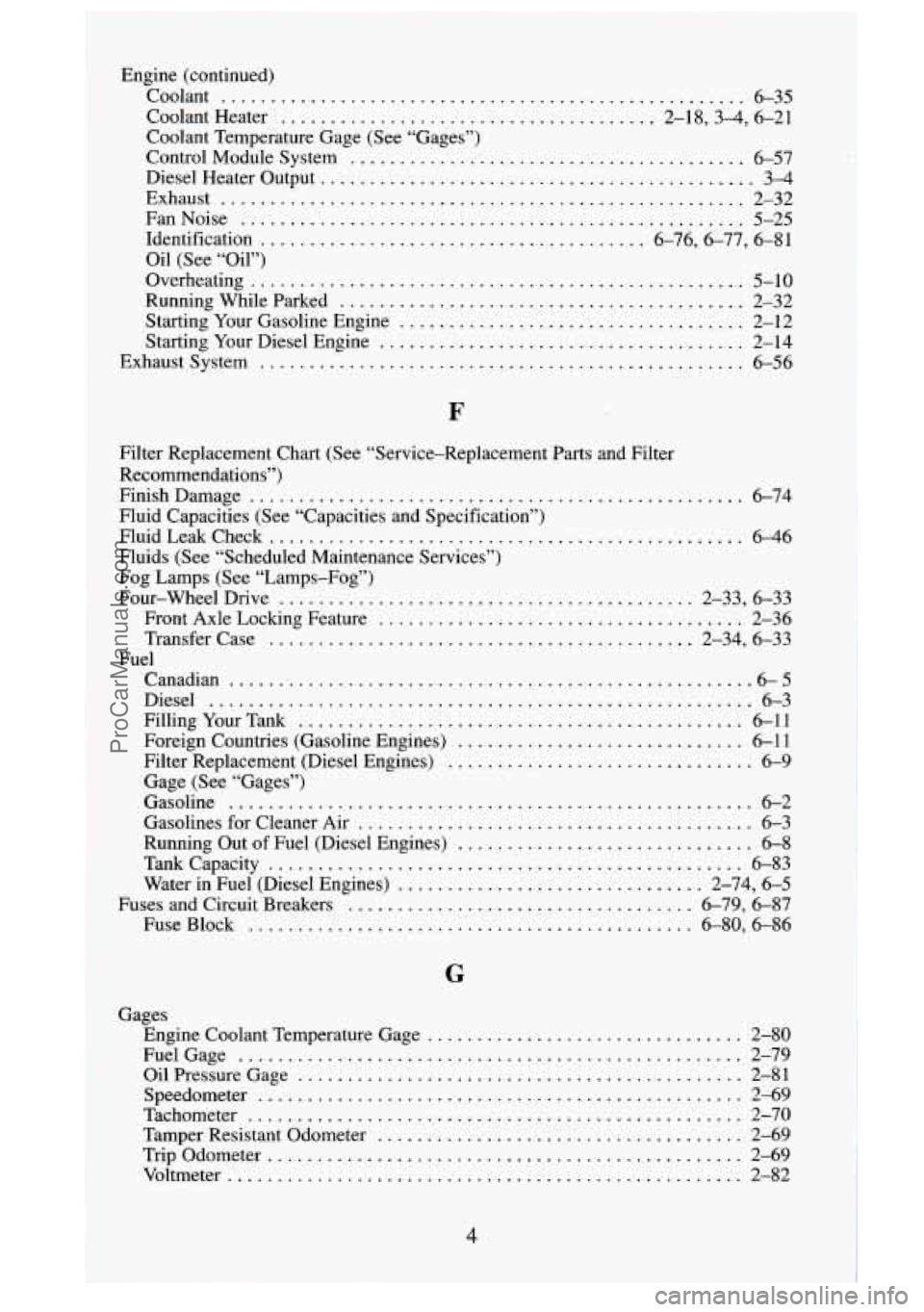Page 304 of 488
To Check Coolant
A CAUTION:
Turning the surge tank pressure cap when the engine and
radiator are hot can allow steam and scalding liquids to blow out
and burn you badly. Never turn the surge tank pressure cap
-
even a little - when the engine and radiator are hot.
When your engine is cold, the coolant level should be at the COLD mark, or
a little higher.
If this light comes on, it means you’re low on engine coolant.
To Add Coolant
If you need more coolant, add the proper mix ut the surge tmk, but only
when the engine is cool. If the surge tank is empty, see “Engine
Overheating”
in the Index for the proper fill procedure.
A CAUTION:
You can be burned if you spill coolant on hot engine parts.
Coolant contains ethylene glycol, and
it will burn if the engine
parts are hot enough. Don’t spill coolant on a hot engine.
When replacing the pressure cap, make sure it is tight.
6-38
ProCarManuals.com
Page 305 of 488
Radiator Pressure Cap - Gasoline Engine
The radiator pressure
cap must be tightly
installed with
the
arrows on the cap
lined up with the
overflow tube on the
radiator filler neck.
NOTICE:
Your radiator cap is a 15 psi (105 kPa) pressure-type cap and
must be tightly installed to prevent coolant loss and possible \
engine damage from overheating. Be sure the arrows
on the cap
line up with the overflow tube on the radiator filler neck.
Surge Tank Pressure Cap - Diesel Engine
The surge tank
pressure cap must be
tightly installed with
the arrows on the cap
lined up with the top
tube of the coolant
surge tank.
6-39
ProCarManuals.com
Page 306 of 488

NOTICE:
Your surge tank pressure cap is a unique 15 psi (105 kPa)
pressure-type cap for use with surge tank cooling systems only.
It must be tightly installed to prevent coolant loss and possible
engine damage from overheating. Be sure the arrows on the cap
line up with the top tube of the coolant surge tank.
Thermostat
Engine coolant temperature is controlled by a thermostat in the engine
coolant system. The thermostat stops the flow
of coolant through the
radiator until the coolant reaches a preset temperature.
When you replace your thermostat, an AC@ thermostat is recommended.
Power Steering Fluid
How To Check Power Steering Fluid
When the engine compartment is cool, unscrew the cap and wipe \
the
dipstick with a clean rag. Replace the cap and completely tighten it. Then
remove the cap again and look at the fluid level on the dips\
tick.
The level should be at the
FULL COLD mark. Add enough fluid to bring
the level
up to the mark.
A fluid loss in this system could indicate a problem. Have the system
inspected and repaired.
6-40
ProCarManuals.com
Page 476 of 488

Engine (continued)
Coolant
..................................................... 6-35
Coolant Heater
...................................... 2.18.3-4. 6.21
Coolant Temperature Gage (See “Gages”)
Control Module System
........................................ 6-57
Diesel Heater Output
............................................ 34
Exhaust
..................................................... 2-32
FanNoise
................................................... 5-25
Identification
....................................... 6-76,677, 6-81
Oil (See “Oil”)
Overheating
.................................................. 5-10
RunningWhileParked
......................................... 2-32
Starting Your Gasoline Engine
................................... 2-12
Starting Your Diesel Engine
..................................... 2-14
Exhaustsystem
................................................. 6-56
F
Filter Replacement Chart (See “Service-Replacement Parts and Filter
Recommendations”)
FinishDamage
.................................................. 6-74
Fluid Capacities (See “Capacities and Specification”)
FluidLeakCheck
................................................ 646
Fluids (See “Scheduled Maintenance Services”)
Fog Lamps (See “Lamps-Fog”)
Four-WheelDrive
.......................................... 2-33, 6-33
Front Axle Locking Feature
..................................... 2-36
Transfer Case
........................................... 2-34, 6-33
Canadian
...................................................... 6-5
Diesel
....................................................... 6-3
FillingYourTank
............................................. 6-11
Fuel
Foreign Countries (Gasoline Engines)
............................. 6-11
Filter Replacement (Diesel Engines)
............................... 6-9
Gage (See “Gages”)
Gasoline
..................................................... 6-2
Gasolines for Cleaner Air
........................................ 6-3
Running Out of Fuel (Diesel Engines)
.............................. 6-8
Tankcapacity
................................................ 6-83
Water in Fuel (Diesel Engines)
............................... 2-74, 6-5
Fuses and Circuit Breakers ................................... 6-79, 6-87
FuseBlock
............................................. 6-80, 6-86
G
Gages Engine Coolant Temperature Gage
................................ 2-80
Oil Pressure Gage
............................................. 2-81
Tamper Resistant Odometer ..................................... 2-69
Trip Odometer
................................................ 2-69
FuelGage
................................................... 2-79
Speedometer
................................................. 2-69
Tachometer
.................................................. 2-70
Voltmeter
.................................................... 2-82
4
ProCarManuals.com
Page:
< prev 1-8 9-16 17-24